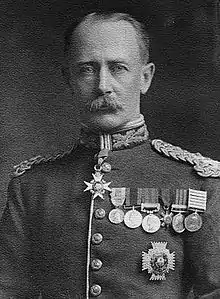Bruce Hamilton (British Army officer)
General Sir Bruce Meade Hamilton, GCB, KCVO (7 December 1857 – 6 July 1936) was a British Army General during the Second Boer War and the First World War.
Sir Bruce Meade Hamilton | |
|---|---|
 Gen. Sir Bruce Hamilton | |
| Born | 7 December 1857 |
| Died | 6 July 1936 (aged 78) |
| Allegiance | |
| Service/ | |
| Rank | General |
| Commands held | |
| Battles/wars |
|
| Awards |
|
Early life
He was born the second son of General Henry Meade Hamilton. His three brothers all became officers in the British Army, including the third son Hubert Ion Wetherall Hamilton.[1]
Military career
Hamilton was commissioned into the East Yorkshire Regiment in 1877.[2] He served in the Second Anglo-Afghan War in 1880 and the South African War in 1881.[2] He became Commander of the Niger Coast Protectorate Force in Benin in 1897.[2]
Bruce took part in the Second Boer War from 1900 until 1902.[2] He played a key role in the capture of Naauwpoort.[3] During the latter part of the war he was in command of the military columns operating in Eastern Transvaal,[4] and following the announcement of peace on 31 May 1902, he supervised the surrender of arms in that area.[5] In his final despatch from South Africa in June 1902, Lord Kitchener, Commander-in-Chief of the forces during the latter part of the war, described Hamilton as an officer "possessed of qualities of boldness, energy and resolution in no common degree".[6] He left Cape Town on board the SS Walmer Castle in late June 1902,[7] and arrived at Southampton the following month. In the South Africa honours list published on 26 June 1902, Hamilton was appointed a Knight Commander of the Order of the Bath (KCB),[8] and he invested as such by King Edward VII at Buckingham Palace on 24 October 1902.[9]
After his return, he was appointed General Officer Commanding 3rd Division within 1st Army Corps in 1902,[10] transferring to 2nd Division in 1904. He was appointed General Officer Commanding-in-Chief for Scottish Command in 1909.[2] He was Army Commander of the Home Defence formations First Army and Northern Army during the First World War.[2]
References
- "No. 24872". The London Gazette. 10 August 1880. p. 4364.
- Sir Bruce Meade Hamilton Liddell Hart Centre for Military Archives
- South African Military History Society
- "Latest Intelligence - The War". The Times (36754). London. 29 April 1902. p. 5.
- "Latest arrangements - The peace, military arrangements". The Times (36785). London. 4 June 1902. p. 7.
- "No. 27459". The London Gazette. 29 July 1902. pp. 4835–4836.
- "The Army in South Africa - Troops returning home". The Times (36811). London. 4 July 1902. p. 9.
- "No. 27448". The London Gazette (Supplement). 26 June 1902. p. 4191.
- "Court Circular". The Times (36908). London. 25 October 1902. p. 8.
- "Army Corps appointments". The Times (36871). London. 12 September 1902. p. 6.
| Military offices | ||
|---|---|---|
| Preceded by |
General Officer Commanding the 3rd Division 1902–1904 |
Succeeded by |
| Preceded by Charles Douglas |
General Officer Commanding the 2nd Division 1904–1907 |
Succeeded by Theodore Stephenson |
| Preceded by Sir Edward Leach |
GOC-in-C Scottish Command 1909–1913 |
Succeeded by Sir James Wolfe Murray |